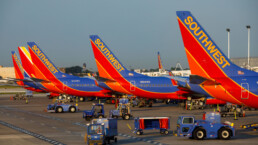Our system is set up to create mutual antagonism between members of the working class. Meanwhile, faceless corporate executives remain shielded like mob bosses.
by Adam Johnson, The Column
Recent viral images of Southwest agents getting yelled at and crying have resurfaced a valuable lesson about the nature of our economic system that’s worth examining this holiday season: the deliberate, built-in ways corporate “customer service” is set up to not only shield those on the top of the ladder—executives, vice presidents, large shareholders—but pit low-wage workers against each other in an inherently antagonistic relationship marked by powerlessness and frustration. It’s a dynamic we discussed in “Episode 118: The Snitch Economy—How Rating Apps and Tipping Pit Working People Against Each Other,” of the Citations Needed podcast I co-host, but I feel ought to be expanded on in light of recent events. Watching video after video, reading tweet after tweet, describing frustrated stranded holiday travelers yelling at Southwest Airlines workers, and hearing, in turn, accounts of airline workers and airport staff breaking down crying, is a good opportunity to talk about how none of this is natural or inevitable. It is a choice, both in corporate policy and government regulation.

There are three main ways capital pits workers against each other in the relationship we call “customer service”:
1. Snitch economy. As discussed in Citations Needed Ep. 118, we are provided with more and more apps, websites, and customer surveys to effectively do the job of managing for management—free of charge, of course. Under the auspices of “empowering” the consumer, we are told to spy on our low-wage servants and gauge the quality of their servitude with stars, tips, and reviews. Uber, DoorDash, Fiver, Grubhub—a new “gig economy” has emerged that not only misclassifies workers as freelancers to pay them less, but hands over the reins of management to the consumer directly. This necessarily increases the antagonism between working-class consumers and the workers they are snitching on.
2. Automation. Increasingly, even getting to the bottom rung employee to yell at is difficult. Under the thin pretense of Covid, increased labor power has exploded the use of automated technology that creates a frustrating maze to get a simple problem solved or task accomplished. Don’t go to the register, instead download the app and order. Scan the QR code, don’t wait on hold, go to our website and engage a series of automated prompts and maybe you can solve your problem. More and more consumers are being pushed away from humans onto automated systems we are told will “save us time,” but instead exist solely to save the corporation labor costs. So, by the time the average consumer does finally work their way to seeing a human, they are annoyed, frustrated, and angry at this faceless entity and more willing to take it out on someone making $13 an hour.
Recent Posts
‘Unconstitutional. Unethical. Authoritarian.’ ICE Bars Millions Of Immigrants From Bond Hearings
July 18, 2025
Take Action Now One watchdog said the new policy “seems like a blatant attempt to stop them from exercising their right to due process.”……
Americans Are Not Nearly Alarmed Enough About Climate Change
July 18, 2025
Take Action Now Americans still don’t comprehend how imminent, dangerous, and far-reaching the threat is—and journalists are partly to blame.By…
The IRS Is Building A Vast System To Share Millions Of Taxpayers’ Data With ICE
July 17, 2025
Take Action Now ProPublica has obtained the blueprint for the Trump administration’s unprecedented plan to turn over IRS records to Homeland Security…
Israel’s Sudden Assault On Syria Is Unchecked Aggression
July 17, 2025
Take Action Now Jerusalem is bombing Damascus and threatening al-Sharaa’s rule, while Washington was hoping to help the nascent government on…




